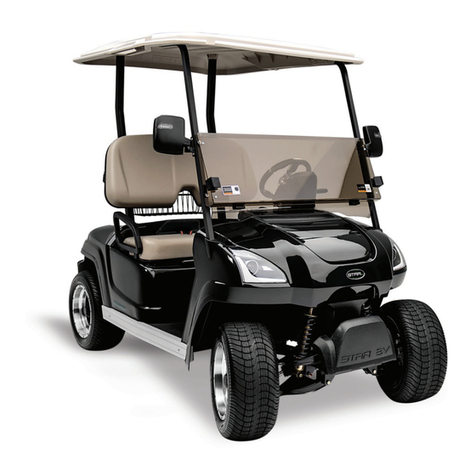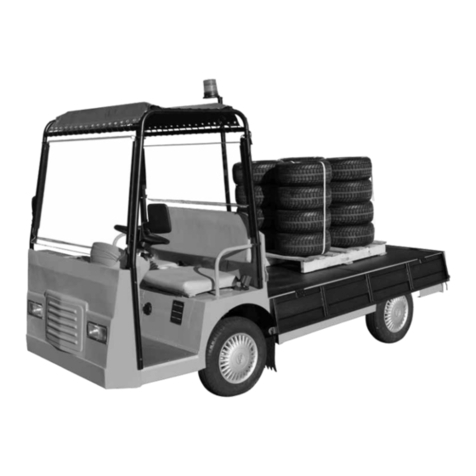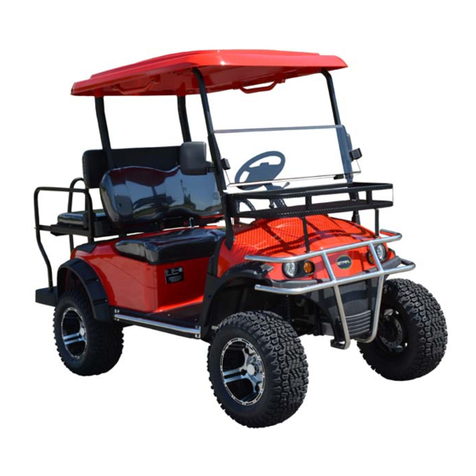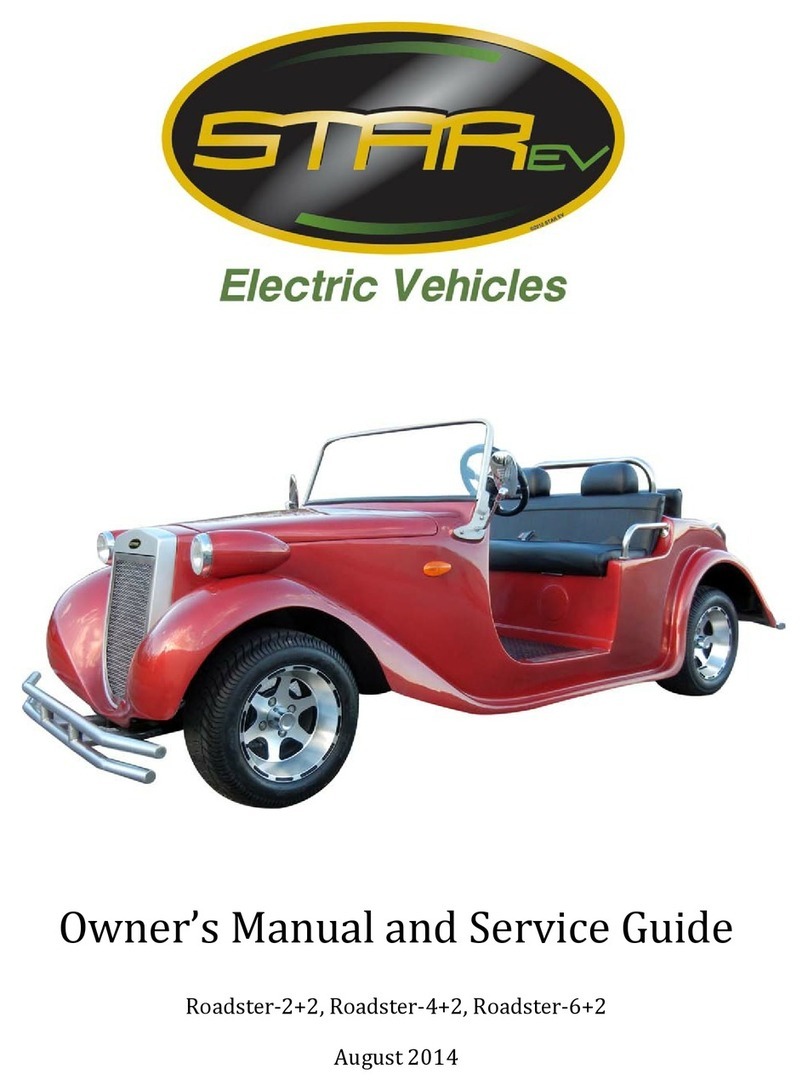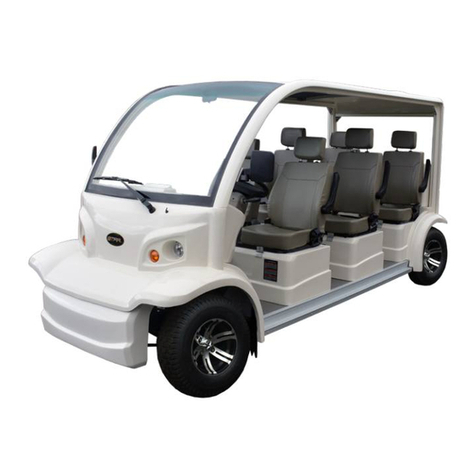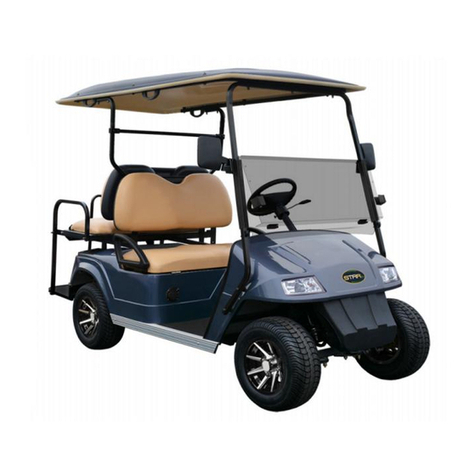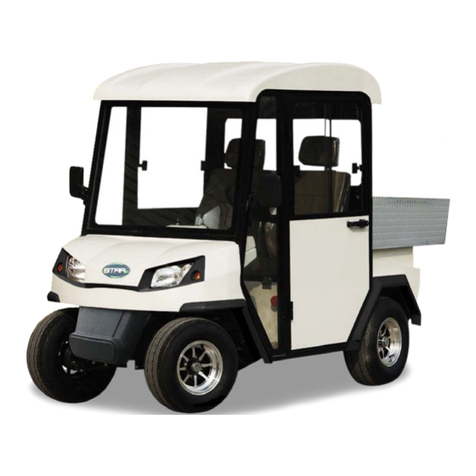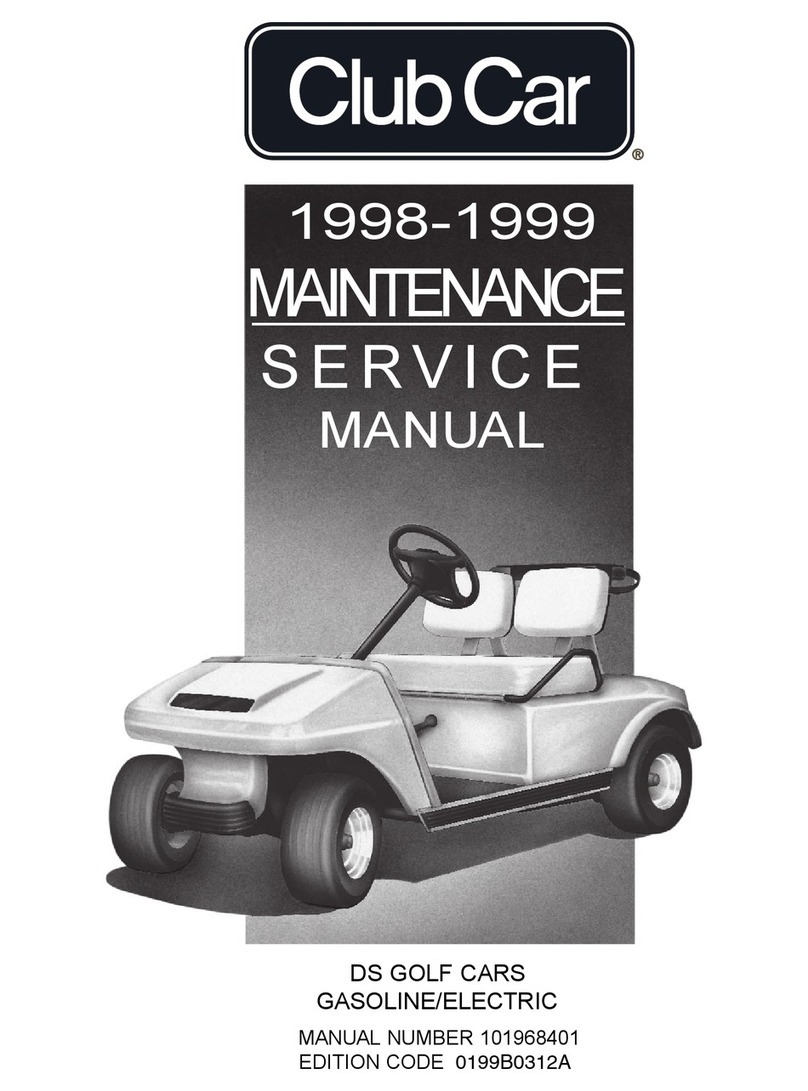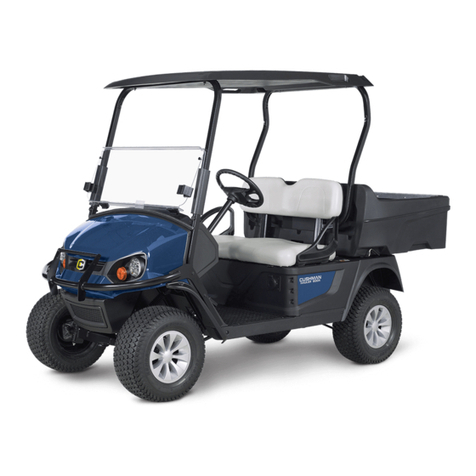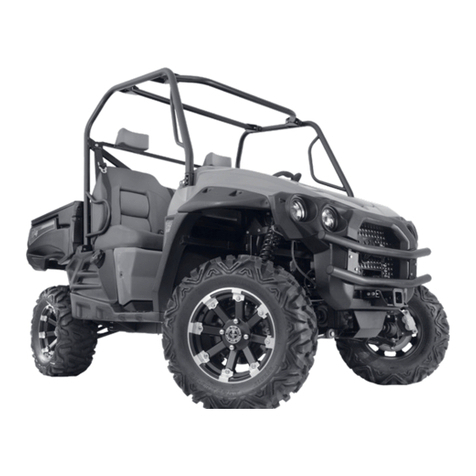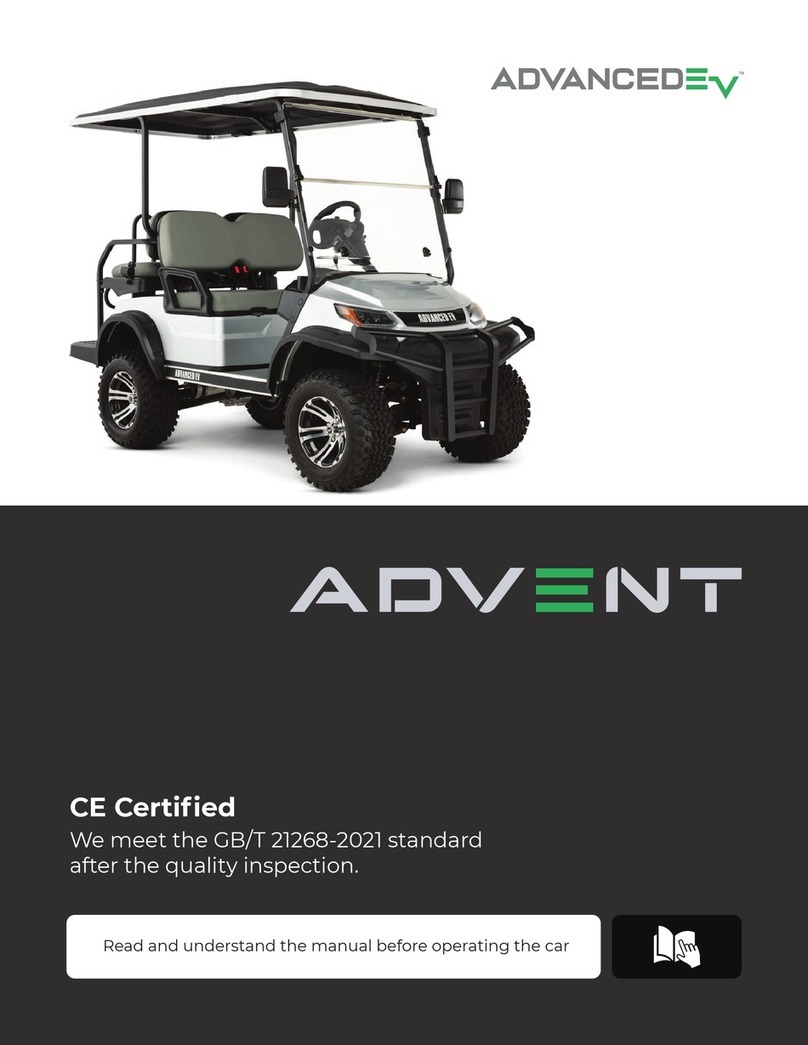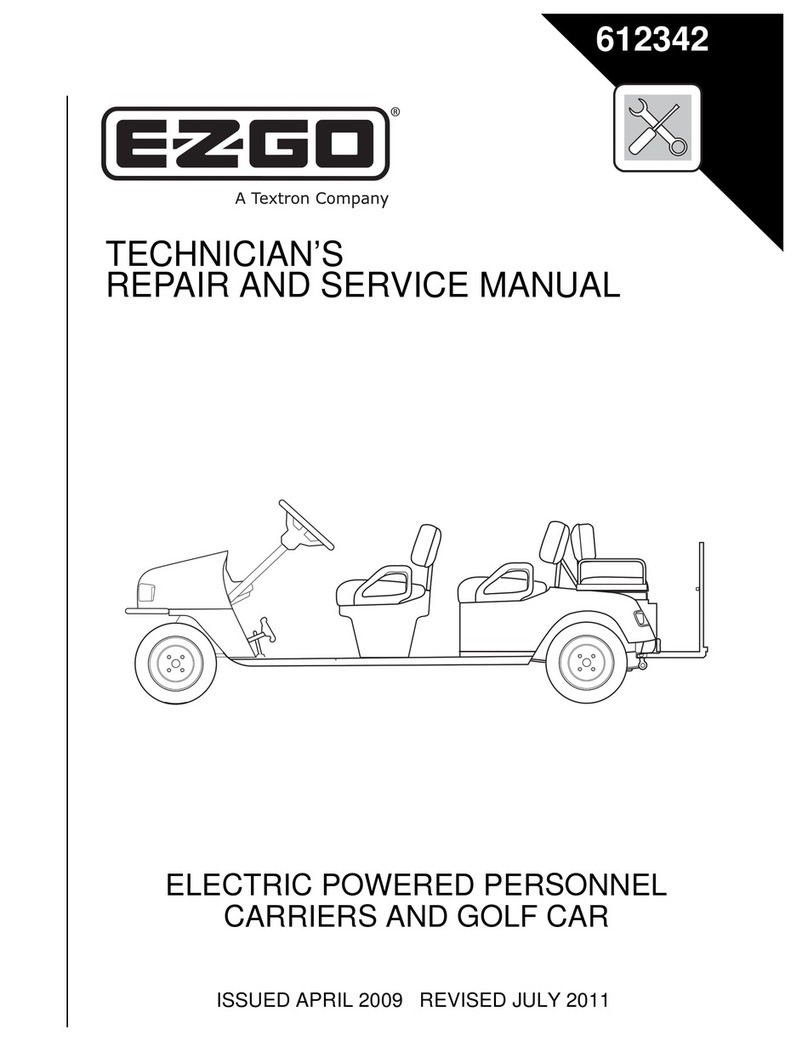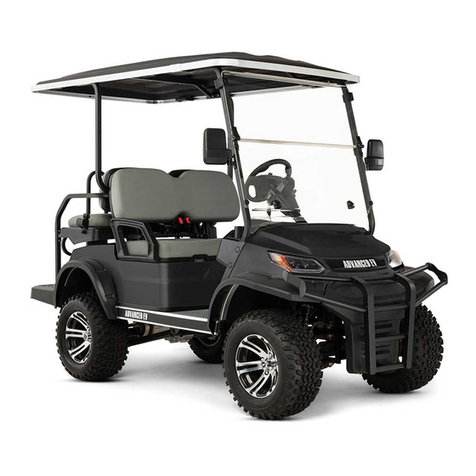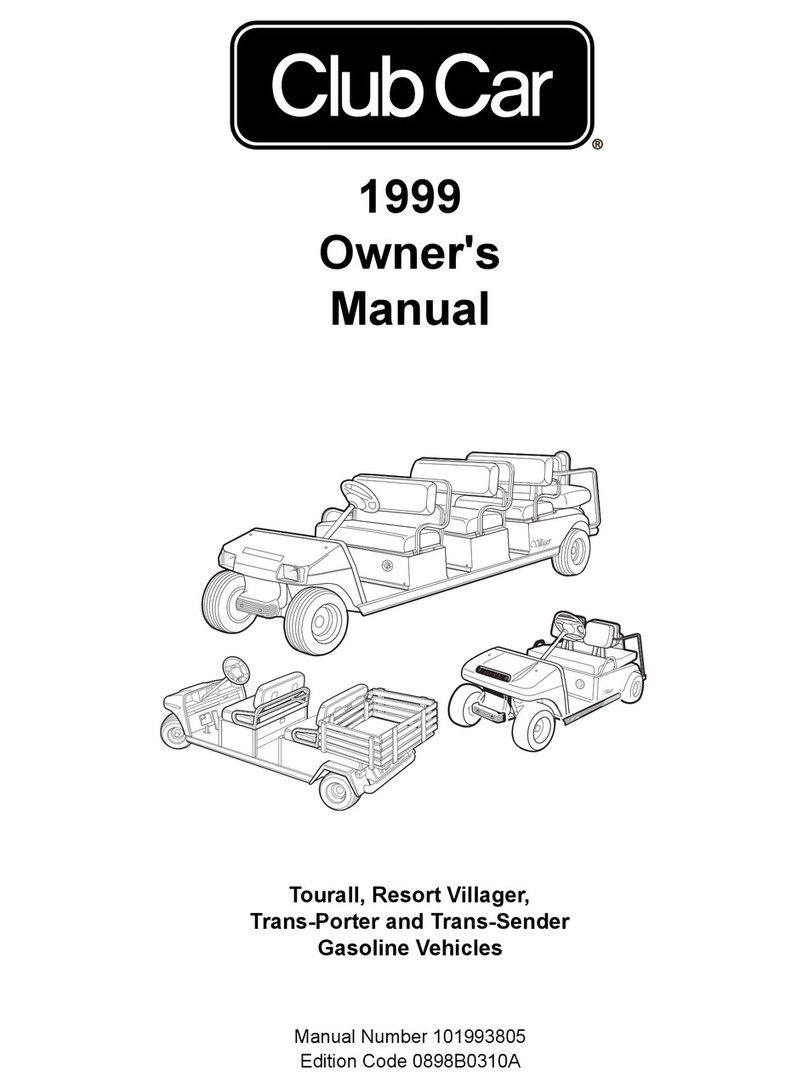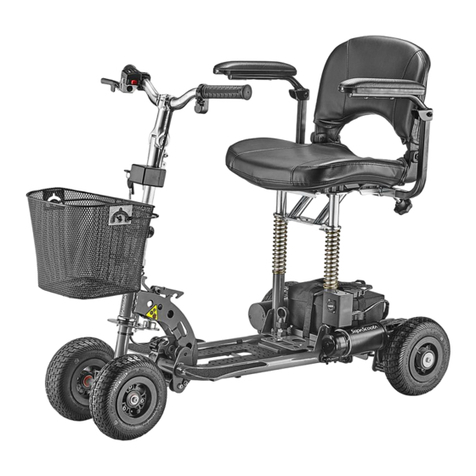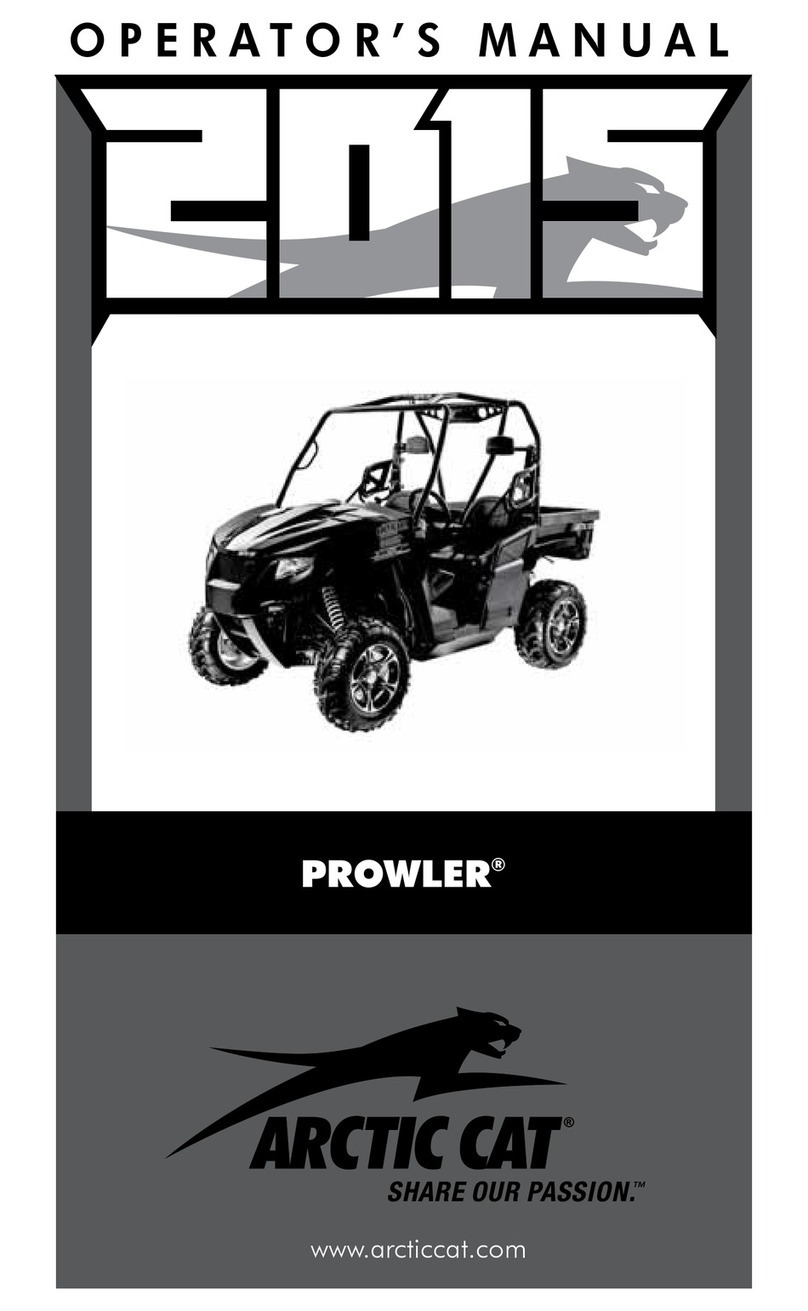Star EV Roadster 2+2-AC User manual

Owner’s Manual and Service Guide
Roadster:
Roadster 2+2-AC and Roadster 4+2-AC

2
Thanks for buying the Star EV Roadster. This manual contains infor-
mation you will need for proper operation, maintenance, and care
of your Roadster. A thorough understanding of these simple instruc-
tions will help you to obtain maximum enjoyment from your new Star
EV.
If you have any questions about the operation or maintenance of
your Roadster, please consult your Star EV dealer.
Read and understand this manual completely before operating your
Star EV.
This manual should be considered a permanent part of your Roadster
and should remain with the car when lending or resold.

3
Table of Contents
4
4
6
7
8
9
11
11
11
11
12
13
14
14
Vehicle Specifications
Operation
User Information
Driver Information
Driving
New Vehicle Inspection
Maintenance
Battery Maintenance
Brake System Maintenance
Steering System Maintenance
Motor Maintenance
Lubrication Maintenance
Maintenance Schedule
Troubleshooting
Aer-Sale Service
Electrical Diagrams

4
1: Vehicle Specifications
2: Operation
Roadster Roadster 2+2-AC and Roadster 4+2-AC
Passengers 4 of 6 (2 facing backwards on
both) Body Material Fiberglass
Battery System Eight 6 V (48 V) batteries,
Trojan T-105 Front Suspension Leaf spring and shock
Motor Power 7 hp AC motor Steering System Rack and pinion
Controller Power 450 A Curtis AC controller Brake System 2+2: Rear drum
4+2: Four-wheel hydraulic
Top Speed 19.5 mph (20-25 mph if street
legal) Tire Size 20x9-12 DOT tires
Load Capacity 2+2: 800 lbs / 4+2: 1,080 lbs Tire Pressure 40 psi
Dimensions 2+2: 140” x 53” x 46” (L x W x H)
4+2: 167” x 53” x 50” (L x W x H) Wheel Type 12” machined aluminum
Weight w/ Batteries 2+2: 1440 lbs / 4+2: 1620 lbs Roof Optional (71"H)
Ground Clearance 5.9" Windshield Fixed tempered glass
Turning Radius 2+2: 14 / 4+2: 17 Drive Train Direct rear drive with 10.25:1
ratio
Wheel Base 2+2: 67” / 4+2: 116” Voltage Reducer 20 A, 48 V to 12 V reducer
included
Top Climbing Grade 25% Warranty
Four year limited warranty,
two year bumper-to-bumper
warranty (less wear items)
1. Dashboard
2. Steering wheel
3. Combination switches
4. CD player (optional)
5. Brake pedal
6. Forward/reverse switch
7. Accelerator pedal
8. Key switch
9. Cigarette lighter
10. Speakers (optional)
11. Charger socket
12. Turn signal lever, horn
and light switch
13. Cup holders

5
1. Speed gauge mounting point
2. Speedometer
3. Lights on indicator
4. Le turn signal indicator
5. Power display
6. Right turn signal indicator
7. Brake light
Notes:
• Low battery voltage alarm light: Red when battery voltage is low.
• Turn signal: The turn signal lever has a button on the end. Push in to sound
horn; pull lever back to turn on lights.
• High beam: The indicator will light up yellow when high beams are on.
Forward/Reverse switch: The switch has three positions. The vehicle goes for-
ward when FWD is pressed down and backward when REV is pressed down. When
the switch is centered, vehicle is in the neutral position. WARNING: Do not shi be-
tween forward and reverse when vehicle is running or damage to the transmission
and/or motor can occur.
WARNING: Before leaving the cart, put the Forward/Reverse switch in neutral.
Before moving forward or reverse the parking brake should be released to pre-
vent serious damage to the brake system and related parts.
Turn signal: Push lever up to illuminate right turn signal; push down to illuminate
le turn signal.
Headlight switch: Pull turn signal lever into back position to turn lights on. Push
back forward for lights to be in o position.
On: All power systems are on when in this position.
O: key can only be removed in this position.
WARNING: Do not take out the key when the vehicle is
running. Do not leave key in ignition to avoid the or
accidental operation by a child.

6
Horn: Press down the horn button on the end of the turn signal lever to engage
horn.
Parking brake: The parking brake will click and lock in the down position to in-
dicate that the parking brake is engaged. Lightly push on the accelerator pedal to
release the parking brake.
Braking: Depress the brake pedal to brake.
Accelerating: Press the pedal and control speed by force applied to the pedal.
Charging, Charger Socket: Plug the larger round plug end into the vehicle charge
port. Plug the power cord end into a standard outlet (110 V) to begin the recharging
cycle. See charging section (p. 11).
Cigarette lighter: Plug in any 12 V DC accessories into outlet. Ideal for use of MP3,
phone chargers, mini fans and other accessories.
3: User Information
Read all vehicle specifications, and use the vehicle according to manufacturer rec-
ommendations.
Do not modify the vehicle without manufacturer’s approval. Any modifications will
aect the function, safety, and warranty of vehicles.
Any replacements of spare parts by an authorized STAR EV dealer (i.e., changing
batteries, tires, seats, etc.) shouldn’t aect the safety requirements. Do not attempt
to li the suspension of this vehicle as serious injury could occur and the vehicle
will no longer be warranted by the manufacturer.
This is a low speed electric vehicle, and should be used on approved roads and
meet the road regulations. Carefully review the laws for golf car and low speed ve-
hicle use in the city and state you are operating the vehicle in.

7
4: Driver Information
It is recommended that only persons with a valid motor vehicle driver’s license be
allowed to operate the vehicle.
The driver should pay close attention to road conditions, pedestrians and other
vehicles on the road.
Remind passengers to buckle seat belts and keep arms and legs inside the vehicle
at all times when it is moving.
Report accidents to your insurance company.
The driver should not modify, add or remove any parts of the vehicle. Do not add or
install any optional steering wheel unless they are designed to fit this vehicle. See
authorized dealer in your area for help.
The driver should operate vehicles in approved areas.
Driving
Operation Procedure
1. Insert the key and turn it to ON position.
2. Press the green forward switch (or reverse).
3. Release the parking brake by lightly pressing on the accelerator pedal. The
speed will increase as pedal is pressed downward.
4. When stopping the vehicle, release the accelerator pedal and depress the
brake pedal slowly. Then push down the parking pedal aer stopping to
engage the parking brake.
Safety
• Release the parking pedal before driving to avoid any damage to the brake
shoes or motor.
• Do not depress the accelerator pedal too aggressively or frequently or it
will shorten the life of the drive train and components.
• Do not start, stop, or turn at high speeds.
• Do not pass other vehicles traveling in the same direction at intersections,
blind spots, or at other dangerous locations. Follow all traic laws.
• Avoid running over loose objects, potholes, and bumps to avoid damage
to the vehicle and possible injury to passengers.
• Please observe and obey all traic regulations, including the passenger

8
and weight capacity requirements, authorized speed limits, and other reg-
ulations.
• Keep a clear view of the path of travel. Observe other traic and pedestri-
ans, and maintain a safe distance, based on speed of travel, from a vehicle
ahead.
Driving on hilly terrain
• Ascend or descend grades slowly.
• Do not turn around when driving on a sharp incline or decline. Be careful
when driving near to the edge of the slope.
Parking safety tips
• Park the cart on flat and solid ground.
• Depress the brake pedal. Keeping the direction switch in neutral position,
turn o the ignition switch and take out the key. Make sure that the brake
pedal is locked in park. You will hear a load click when the parking brake
is engaged.
• Keep the vehicle stored inside of a garage if possible. Don’t leave it outside
in snow or rain, as water can get into the electrical system which will cause
damage. Check with your local dealer about the advantages of a car cover
if you cannot park the vehicle in a garage, car port, or similar covering.
New Vehicle Inspection
Before a new vehicle is put into operation, the items shown below must be per-
formed.
1. Check status of each spare part, especially the nut on the steering wheel
and braking system.
2. Check for any leakage problems with the steering system, turning system
and transaxle.
3. Check the water level of each battery. Maintain proper levels (see Trojan
battery guide) and do not overfill battery cells.
4. Check if tire inflation is correct. Low pressure will lead to diiculty turning
and bumpy riding. Keep the normal air pressure for the tire to prevent pre-
mature wear. Recommended tire pressure is 30 PSI.
5. Check for any worn items between the wiring and other locations where
parts rub against each other.

9
5: Maintenance
• Turn o the electricity, take out the key and push down on the parking
brake.
• When working underneath vehicles, please use jack and triangle wood to
fix the front and rear wheels, in order to avoid accidents.
• Keep the maintenance area clean and safe.
• Please perform vehicle maintenance according to safety guidance. Refer to
STAR EV preventative maintenance schedule or visit an authorized dealer.
• Maintain the ventilation of working sites.
• Check and maintain safe working conditions. Check and maintain the
braking, steering, speed direction control system, emergency facilities,
head/rear lights, controller, and safety equipment.
• Check the battery cover caps to ensure they are snapped into place.
Battery Maintenance
• The batteries for this vehicle have high current, high capacity, and a long
lifetime. To keep the vehicle in good performance, it is very important to
maintain it in the correct procedure.
• The connectors on the batteries are the output connectors. Keep the area
clean and dry, with no foreign matter or dust on it. Proper care will ensure
batteries’ performance and longevity.
• WARNING: Do not use tap water when filling cells. Use distilled water only!
• Check the height of the electrolyte periodically. Check it once per week in
summer and once every two weeks the rest of the year. Standard height
level is 10-15mm (½“) higher than the battery plate. If is too low, please
add the recommended distilled water.
• Keep the wiring well-connected. Aer using the vehicle initially for 2-3
days, the completed inspection for all connectors should be carried out.
Inspect the vehicle once a week following. Any loose or rusty connectors
should be fixed. Loose or rusty connectors can cause high temperature,
damage, or possible sparking.
• NOTE: Don’t over-tighten terminals!
• Charge the battery immediately aer discharge, or it will aect the battery
life. Charge the batteries that are in long storage or non-fully charged sep-
arately.
• Keep the filling-water container clean, so no impurities will be put into the
battery.
• When the environment temperature is under -40° F, the density of the elec-
trolyte aer charging is 1.28 - 1.29 g/cm3. If it is more than 1.30 g/cm3, the
battery can be damaged badly. Add water immediately to keep the elec-

10
trolyte value to normal. If the battery discharges by 80% (the electrolyte is
between the range 1.13 - 1.15 g/cm3), charge it immediately. At this range
the vehicle can only last 2 - 3 mi. Don’t discharge any longer, or it will dam-
age the battery.
• Charge the battery fully before storage. Charge it at least once a month
for 24 hours. Discharge the batteries and charge it once again before use.
• See an authorized dealer for further help and maintenance.
Charging
• In order to optimize battery life, please use the recommended charger to
recharge the batteries.
• Keep the key switch in OFF position during charging.
• Keep the charger in a cool, dry location and avoid moisture.
• Charging should be monitored.
• NOTE: When disconnecting the charger, be sure to unplug cord from AC
power source first then unplug cord connected to vehicle.
Battery Replacement
1. Replace the batteries immediately when approaching the end of the bat-
tery’s life. The capacity of a battery at the end of its life will decrease quick-
ly and won’t meet the standard range (miles on full charge). Consult with
the supplier or dealer for a detailed battery replacement.
2. Remove battery tie-downs and cables. Li out batteries with a commer-
cially available liing device. If the batteries have been cleaned and any
acid in the battery rack area has been neutralized as recommended, no
corrosion to the battery racks or surrounding area should be present. Any
corrosion found should be immediately removed with a putty knife and a
wire brush. The area should be washed with a solution of sodium bicar-
bonate (baking soda) and water and thoroughly dried before priming and
painting with a corrosion resistant paint.
3. The batteries should be placed into the battery racks and the battery tie-
downs tightened to 45 - 55 in. lbs. (5 - 6 Nm) torque to prevent movement
but not tight enough to cause distortion of the battery cases.
4. Inspect all wires and terminals. Clean any corrosion from the battery ter-
minals or the wire terminals with a solution of sodium bicarbonate (bak-
ing soda) and clean with a wire brush. WARNING: To prevent battery ex-
plosion that could result in severe personal injury or death, extreme care
must be used with aerosol containers of battery terminal protectant. Insu-
late the metal container to prevent the metal can from contacting battery
terminals which could result in an explosion.
5. Use care to connect the battery wires as shown. Tighten the battery post

11
hardware to 50 - 70 in. lbs. (6 -8 Nm) torque. Protect the battery terminals
and battery wires with a commercially available protective coating.
Brake System Maintenance
Adjust the gap between the brake drum and brake shoes. Dial up the adjusting
ratchet wheel of the brake drum until the wheel cannot turn freely, then dial down
the ratchet wheel 7 - 8 teeth.
Steering System Maintenance
Check if there is any damage to the dust cover of the tie-rod. A broken dust cover
will let water in and damage the tie-rod, and the steering system will not be flexi-
ble. Replace a new one immediately once a worn one is found. Make sure the front
wheel toe-in is between 3 - 5 mm (1/8 – 3/16”). If it exceeds this value, adjust the
tie-rod screw stem.
Motor Maintenance
The drive motor is an AC motor. Keep the motor surface clean at all times. Clean the
surface with a dry cloth. Avoid any water contact inside motor.
Lubrication Maintenance
• Check the brakes once a month. Fill it full if brake fluid is low in master
cylinder. The front hub, front wheel bearing, brake system, and steering
system should be filled once every year with #3 general lithium based lu-
bricant.

12
• The gear oil should be changed once a year. User can choose gear oil ac-
cording to the climate. (Summer: GL-4 90, Winter: GL-80W/90)
• Replace the grease for the rear axle once a year, using recommended
oil type GL-5 90 and GL-5 80W/90. Fill the level to 1.2 liters (40 oz). When
changing, first twist down the oil plug to discharge the gear oil. Clean the
oil plug and replace it, then inject the new gear oil.
Maintenance Schedule
Item Weekly Monthly Quarterly
Check tire pressure ☑
Check tires for abrasions ☑
Check tightness of the bearing bolt and the tire nut ☑
Tire rotation ☑
Check braking and the parking function ☑
Check brake tube for leakage ☑
Check if brake shoes are worn ☑
Check if steering wheel works freely ☑
Check brake pump ☑
Check tightness for the turning ball joint and rod ☑
Check nut on the steering rack’s spindle ☑
Check tightness of steering rack and bracket ☑
Inspect and adjust front wheel’s toe-in ☑
Checking tightness of front absorber and helix spring ☑
Check height of electrolyte ☑
Check density of electrolyte ☑
Check if the battery’s pole is loose ☑
Clean battery pole by water ☑
Check light and relay performance ☑
Clean and fix wiring connector ☑
Check and adjust front tire’s bearing ☑
Check or replace transaxle ☑
Check performance of gearbox and bearing ☑
Check motor’s bolts and nuts ☑
Clear and lubricate front wheel bearing ☑
Checking motor bearing ☑
Lubricate other parts (use general oil) ☑

13
Problem Possible Reason Processing Methods
Cart cannot move
Operation procedure is wrong Refer to user manual
Wiring connector is corroding
Cut o the power, remove the
nut, clean the connector and
replace the nut
Battery power is low Charge the battery
Direction switch is damaged Replace part
Accelerator is damaged Replace part
Direction contactor is dam-
aged Replace part
Wiring is loose Repair or replace parts
Vehicle moves slowly and/or stops when
climbing
Vehicle is overloaded resulting
in the shutting o the control-
ler when temperature reaches
167° F
Lighten the load of the vehicle
to decrease the temperature
Releasing the accelerator pedal does not
slow down the vehicle
The spring for the accelerator
pedal is broken and the pedal
cannot reposition
Shut o the ignition lock, step
on the parking pedal ,then
contact with the supplier
No indication (LEDs) on the dashboard Parts are loose Lock the inserted parts
Fuse is burned out Replace the fuse
Bumpy riding
The tire pressure is unbal-
anced Correct the tire pressure
The front and rear wheel are
not aligned
Correct the assembly of the
wheels
Turning is diicult
Tire pressure is too low Inflate tires
Sha needs lubrication Add lubrication
The direction sha pin or
joints are damaged Replace parts
Turning excessively
Tie-rod is damaged Replace part
Steering rack has not been
adjusted well or abased Adjust or replace
The direction sha is loose Tighten direction sha
Lack of power, slow response
Low battery power Charge the battery
Damaged drive gear Replace
Speed control system is faulty Maintain speed control system
Rear bearing is leaking oil
Axle of the tire or the washer is
damaged Replace parts
Too much oil Reduce oil quantity
6: Troubleshooting

14
Problem Possible Reason Processing Methods
Abnormal noise
Drive gear or the bearing is
damaged Tighten
Bearing of front or rear sus-
pension is damaged Replace part
Wheel screw is loose Replace part
Motor’s bearing is damaged Keep clean
Low braking power Brake drum is damaged Replace part
Brake shoe is not clean Keep clean
These possible causes are just for your reference and do not include all causes that result in these listed issues.
7: Aer-Sale Service
Star EV has authorized local dealers that will provide the friendly service and tech-
nical support for end users. Be sure to visit www.starev.com to find a dealer in your
area.
Users can report faulty problems by telephone, fax and email. Keep Star EV deal-
ers informed of the model number, VIN number, estimated delivery time, contract
number and date as well as a detailed description or photos of the faulty parts and
problems, and our team will handle it accordingly.
Do not disassemble.
8: Electrical Diagrams

15
This manual tries to be as sound and elaborate as possible in literal and figura-
tive description as well as technical description on the basis of existing data. At the
same time, JH Global reserves the right to alter the content of this manual and this
manual is subject to change without prior notice; in addition, JH Global has the
final say on the interpretation of this manual.
All rights reserved.

STAR EV, a brand of JH Global Services, Inc.
378 Neely Ferry Road | Simpsonville, SC 29680
www.starev.com
This manual suits for next models
1
Table of contents
Other Star EV Golf Car manuals
